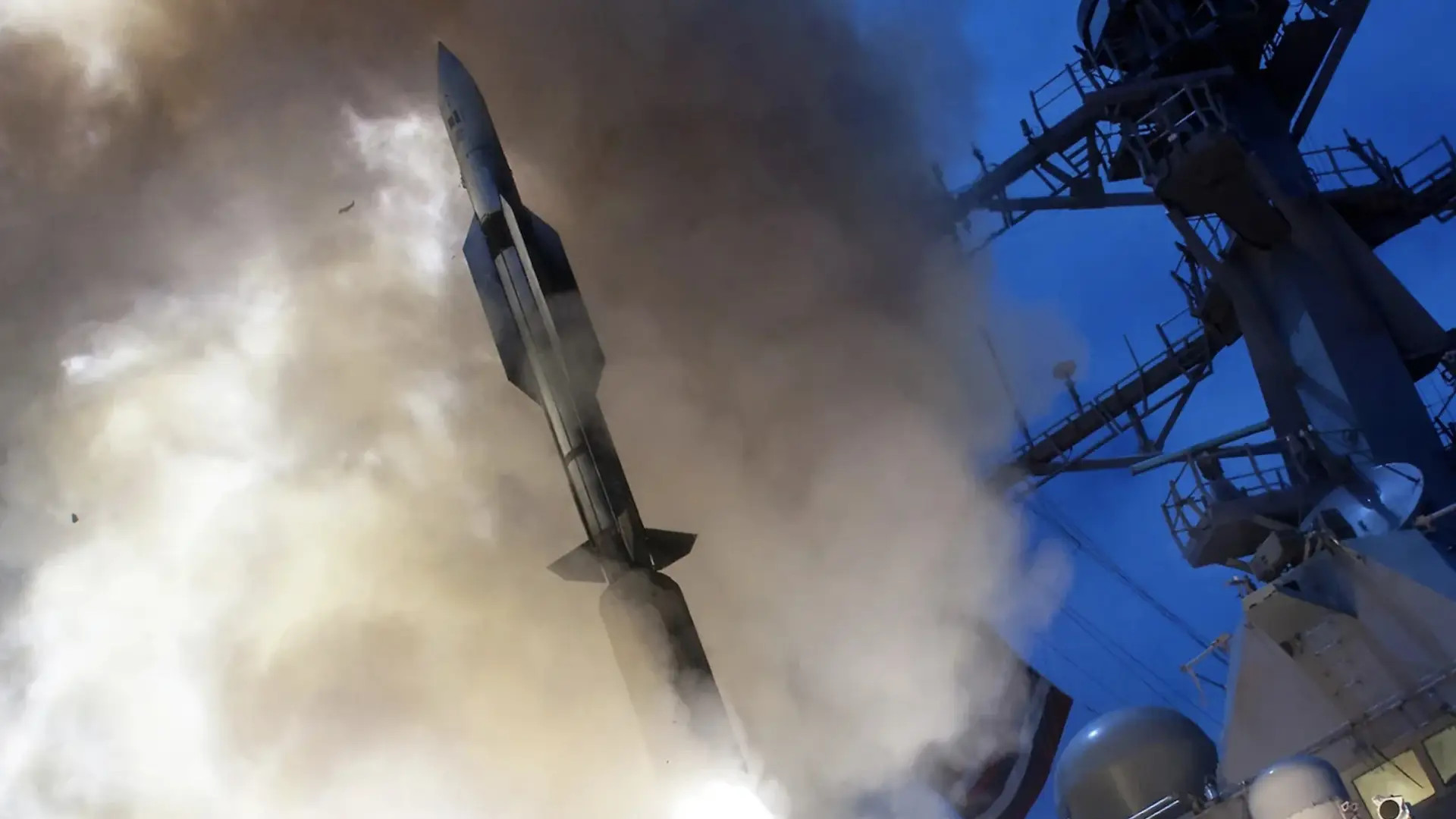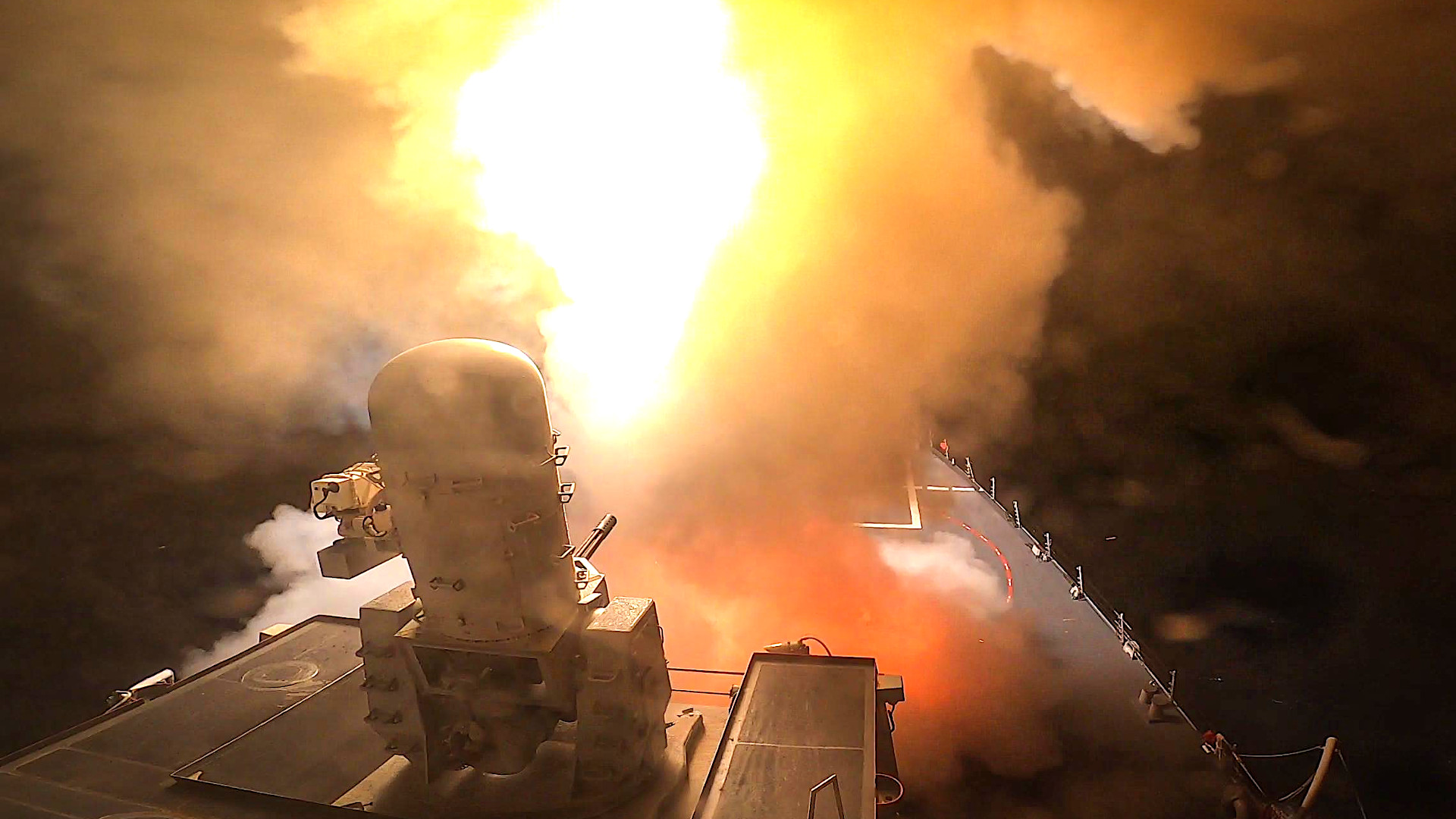The U.S. Navy has fired around 100 Standard family surface-to-air missiles at Houthi missiles and drones launched from Yemen since last October, according to a recent report. This significant expenditure of resources speaks exactly to the kinds of concerns, as well as broader ramifications, that The War Zone recently explored in detail the context of the U.S. Navy’s future Constellation class frigates and its surface combatants’ magazine depth in general, which you can find here.
The new details about how Navy ships have been responding to Houthi attacks came in a report from CBS News‘ “60 Minutes” that was broadcast this past weekend. The Iranian-backed Yemeni militants have been engaged in an anti-shipping campaign in and around the Red Sea since last October. The group has also been launching missiles and drones at Israel.

“We learned that so far in this crisis, the Navy has fired about 100 of their Standard surface-to-air missiles, that can cost as much as $4 million each,” according to the “60 Minutes” story.
The report does not identify what specific types of Standard Missile (SM) U.S. naval forces have been employing or provide any kind of breakdown of the 100 missile total by variant. Past reports and other evidence that has emerged to date indicates that American warships have fired SM-2 and SM-6 types at Houthi Threats. The latest production SM-2 Block IIIC and SM-6 Block IA variants cost around $2 million and $4 million, respectively, according to Navy budget documents. The SM-6 Block IA unit cost is in line with the price point from the “60 Minutes” story.
SM-2 variants, which you can read more about in detail here, are medium-to-long range surface-to-air missiles that can also have a secondary surface strike capability. SM-6s are longer-range and otherwise more capable multi-purpose weapons with anti-aircraft and terminal anti-ballistic missile intercept capabilities, as well as the ability to strike ships and targets ashore. The U.S. military has also said that SM-6 variants offer the only current defense for U.S. warships against highly-maneuverable hypersonic threats.

Shipboard anti-ballistic missile capabilities have become a newly hot topic of discussion thanks to the Houthis. The Yemeni militants have become the first to employ anti-ship ballistic missiles in anger. Just owing to the high speeds they reach in the terminal phase of flight, ballistic missiles present significant additional challenges to defenders.
“If there was an anti-ship ballistic missile launch, this ballistic missile travels at about Mach 5, about 3,000 miles an hour,” Navy Vice Admiral Brad Cooper, the Deputy Commander of U.S. Central Command, said in an interview for the recent “60 Minutes” report. “If it’s coming toward them, now just put yourself in the seat of the destroyer captain on that ship. He has about nine to 15 seconds to make a decision that they’re gonna shoot that down. It’s intense.”
The Houthis have also been layering anti-ship ballistic missiles with cruise missiles and drones, further complicating the entire threat picture. The Yemeni militants have also been employing explosive-laden uncrewed surface vessels (USV). CENTCOM said that U.S. forces recently destroyed a Houthi uncrewed underwater vehicle (UUV), pointing to another threat in the mix, as well.
In addition, “a day before our visit to the [Arleigh Burke class] USS Mason, about a hundred miles away, another U.S. destroyer needed its weapon of last resort, a defensive cannon called a CIWS [Mark 15 Phalanx Close-In Weapon System], to shoot down a Houthi cruise missile that was a mile out and closing fast,” according to “60 Minutes.”
It is unclear whether or not this is the same incident involving the USS Gravely that CNN reported in late January, which also included the detail that the incoming Houthi cruise missile came with a mile of that destroyer. If another destroyer has found itself in a similar predicament, this would also be very concerning. As The War Zone reported when news of the incident involving Gravely emerged, the time, the Phalanx is typically seen as a ‘last ditch’ line of defense and it remains unknown how the Houthi threat was able to get so close to that destoryer before it was shot down.

The Standard Missile launches reported by “60 Minutes,” as well as CIWS incident, underscore concerns about the strains being places on the missile magazines of Navy warships deployed in and around the Red Sea now, as well as in the context of a potential future major conflict, such as one against China. The Houthi anti-ship campaign has also reignited discussions about the risks of existing shipboard defenses being overwhelmed by complex attacks involving different kinds of threats. These are exactly the issues that The War Zone‘s recent feature centered on the Constellation class frigates addressed in detail.
Since October 19 of last year, Navy Arleigh Burke class destroyers have shot down at least 21 Houthi ballistic and cruise missiles and 67 drones, according to statements from CENTCOM. The USS Carney alone is responsible for at least 43 of those intercepts. U.S. aircraft, as well as foreign warships, have shot down additional Houthi threats.
A single Arleigh Burke class destroyer has Mk 41 Vertical Launch System (VLS) arrays with between 90 and 96 cells, depending on the subvariant. However, standard operating procedure means that those cells are filled with a mix of different weapons, and not just surface-to-air missiles like the SM-2 and SM-6. For instance, Navy Burkes have also been firing Tomahawk land-attack cruise missiles at Houthi targets ashore. In addition, it is typical procedure to fire at least two interceptors at a single incoming aerial threat to increase the probability of successfully knocking it down.

RIM-162 Evolved Sea Sparrow Missiles (ESSM), short-to-medium-range surface-to-air missiles which can be quad-packed in a single Mk 41 VLS cell, are also commonly among the loadouts for Navy Arleigh Burke class destroyers. Mention of the ESSM has been curiously absent from discussions about the U.S. response to Houthi threats in and around Red Sea.
No matter what, as has been made clear just in the past in the past 24 hours, the U.S. military and other foreign forces in and around the Red Sea have been unable to intercept 100 percent of Houthi threats. The damage to the cargo ship Rubymar from an attack yesterday was severe enough that the crew was forced to abandon ship, as you can read more about here.
“The weapons systems that you have on board here and specifically the Standard Missiles, those are expensive weapons,” Norah O’Donnell from “60 Minutes” asked Navy Cdr. Justin Smith, commander of the USS Mason, for the recent report from the Red Sea. “And you’re using them to shoot down $10,000 drones. Is that worth it?”
It is worth noting that the cost of Iranian-design kamikaze drones have been the topic of much debate, but is higher than $10,000, as The War Zone recently explored in depth. The price point for those drones, as well as the kinds of missiles the Houthis have been employing, is still likely to be a fraction of the cost of the Standard Missile variants the Navy has been employing in response. All of this largely moot in a real-world operational context involving real-time threats to warships worth billions of dollars and with hundreds of personnel onboard, whose lives are priceless.

“I don’t think you can put a price tag on safety and the defense of our sailors on board,” Smith said in response to O’Donnell’s question, speaking to the the real costs involved in any such engagement.
“You have to be right 100% of the time,” O’Donnell further prompted.
“And they just have to get it right once,” Smith added.
The recent attack on Rubymar certainly underscores the costs of not intercepting Houthi threats. This kind of calculus would only be more pronounced in any future high-end conflict where U.S. forces are facing even greater number of incoming threats and the prospect of more serious attrition, as well as other factors.
If nothing else, the news that the Navy has expended around 100 Standard Missiles over the past four months or so shows the kind of resources that have been required just to address the Houthi’s serious and ongoing anti-shipping campaign. This even more significant to consider given that the volume of threats in any future high-end conflict, such as one against China in the Pacific, would dwarf what is being seen now in and around the Red Sea.
Contact the author: joe@twz.com
